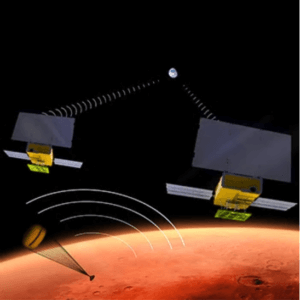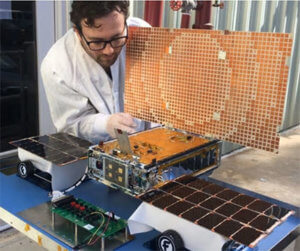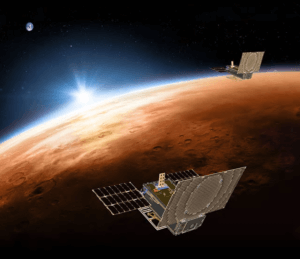Case Study: MMA HaWKs Power First Ever Interplanetary CubeSat Demonstration on JPL’s Mars Cube One “MarCO” Mission
MarCO Mission HaWK Solar arrays
Players: JPL, MMA Design
The Challenge
When JPL came to us with an idea for pushing the limits of what still maturing miniaturized CubeSat technology could do, of course we said YES! (#values) MMA High Watts per Kilogram “HaWKs” had already been flight tested in Low Earth Orbit (LEO), but no CubeSats had ever dared venture into deep space. JPL’s Mars Cube One (MarCO) mission aimed to demonstrate that CubeSats could play an integral role in improving communications as the Mars InSight Lander entered Mars’ atmosphere. MarCO’s A and B, two identical, suitcase-sized CubeSats armed with radio antennas and high-performance MMA HaWK solar arrays, were designed to provide near-real-time data about InSight’s descent and landing on Mars — typically called the “7 minutes of terror.”

The Solution
The MarCO HaWK solar arrays were some of MMA’s first solar arrays developed after achieving commercialization success on AFRL missions commissioned under Small Business Innovation Research (SBIR) grants. Due to the challenging requirements of the MarCO spacecraft and other constraints on the mission, significant advancements were required to make our standard HaWK technologies more flexible and robust. Critical improvements to our design of launch restraints were necessary to bolster the overall strength and reliability of the arrays given the severe deep space environments the arrays would experience during ascent and on-orbit. Innovations to the springs and root hinges were also required since the solar arrays needed to support dual-axis deployment capabilities.

The Results

MarCO twin CubeSats depicted flying over Mars.
In May of 2018, MarCO’s twin CubeSats, nicknamed Wall-E and Eva, launched alongside the Mars InSight Lander from Vandenberg Air Force Base in California on an Atlas V. After traveling independently through deep space for six months, they arrived at the Red Planet in November 2018. The MarCO HaWK solar array configuration (HaWK 17AB36) consists of two, three-paneled solar arrays for each CubeSat, covered in 21 triple-junction GaAs solar cells to generate 36 Watts of electrical power in Earth orbit, and about half the expected power at Mars.
MarCO and our HaWK solar arrays made history, not just for flying past Mars while exceeding peak power expectations, but also for successfully relaying data from NASA’s InSight lander in near-real-time as envisioned (instead of the previously standard 1+ hour delayed comms). Design features derived from MarCO’s solar arrays not only helped MMA further evolve and flight test its space power technologies, but the radio, attitude control system and antennas used by JPL are in CubeSats that NASA launched to the Moon with Artemis I — which incidentally included 4 other missions powered by MMA HaWK Solar Arrays, LunaH-map, EQUULEUS, BioSentinel and NeaScout!

MarCO won SmallSat Mission of the Year in 2019.
Check out our table of existing HaWK configurations, or contact our product specialists for your custom solar array needs.


